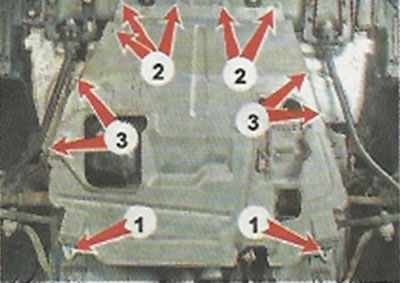Recommendation. The condition of the engine should be monitored regularly during the operation of the vehicle. Signs of malfunctions may be: the presence of oil drops in the parking lot of the car; ignition of the engine malfunction warning lamp or emergency oil pressure warning lamp, the appearance of an extraneous sound (noise, knock) during engine operation; smoky exhaust; moving the arrow of the temperature indicator to the red zone; increased oil consumption, noticeable loss of power. If at least one of the listed signs is detected, a more detailed check is necessary. Checks of the technical condition of engine systems are shown in the relevant sections of the chapter «Engine and its systems» («Checking the technical condition of the cooling system»; «Checking the technical condition of the power system»; «Checking the technical condition of the engine management system»; «Check of a technical condition of system of release of the fulfilled gases»).
It is possible to assess the technical condition of the engine with sufficient accuracy by external signs and with the help of available equipment (compression gauge, manometer, technical stethoscope).
Execution sequence
1. We prepare the car for work and install it on a viewing ditch or overpass («Preparing the car for maintenance and repair»).
2. Using a 10 mm socket wrench, unscrew the two bolts 1 of the rear mounting of the mudguard. With an 8 mm socket wrench, we unscrew the five screws 2 of the front mounting of the mudguard. Using the same wrench, we unscrew two screws 3, fastening the central part of the mudguard to the side parts.

3. Remove the central part of the engine mudguard.
4. We examine the engine. Oil leaks may indicate worn oil seals or seals.
5. We start the engine, while the emergency oil pressure warning lamp should go out. If the control lamp lights up at idle after the engine warms up and goes out after increasing the crankshaft speed, then the following may be worn: oil pump gears, crankshaft journals, main and connecting rod bearing shells. If the lamp is constantly on, then the lubrication system or the emergency oil pressure sensor may be faulty. We check the oil pressure in the engine lubrication system using a pressure gauge («Oil pressure - check»).
Warning! Operating the vehicle with insufficient oil pressure in the lubrication system will result in severe engine damage.
6. After warming up the engine, we listen to its work.
Recommendation. It is convenient to diagnose engine malfunctions by ear with the help of a technical stethoscope. With it, you can quite accurately determine the source of extraneous noise.

Attention! To avoid personal injury, do not touch the moving parts of the engine when performing the following operation (pulleys, belt) and do not touch hot parts of the engine.
7. When an extraneous sound appears with a stethoscope, we determine the area where this sound is most audible. Based on the nature of the sound and the place of sound emission, we determine the possible source of the sound and the possible malfunction.
Comment. A clattering ringing sound under the cylinder head cover, as a rule, indicates a violation of the gaps in the valve drive («Clearances in the timing valve drive - adjustment»), uniform noise in the timing belt area may indicate wear on the tensioner roller bearing or coolant pump bearing. Knocks at the bottom of the cylinder block and from the sump side, which increase with increasing engine speed, are caused by a malfunction of the main bearings. In this case, as a rule, the oil pressure in the lubrication system is low. At idle, this sound is low-pitched, and as the speed increases, its tone rises. When you sharply press the gas pedal, the engine emits something similar to a growl - such as «gyr-r-r». Ringing knocks in the middle of the cylinder block are caused by a malfunction of the connecting rod bearings. Rhythmic metallic knocking in the upper part of the cylinder block, audible at all engine operating modes and intensifying under load, is caused by a malfunction of the piston pins. A muffled knock in the upper part of the cylinder block on a cold engine, which subsides and disappears when warmed up, can be caused by worn pistons and cylinders. Operating the vehicle with defective bearings and pins will result in engine failure.
8. If oil consumption has increased, but no signs of leakage are found:
- A) Warm up the engine at operating temperature.
- b) Disconnect the crankcase ventilation hose from the receiver pipe.
- V) bring a sheet of paper to the hose. If oil stains appear on the paper, then the cylinder-piston group is worn out. The degree of wear is determined by compression in the cylinders («Compression in the engine cylinders - check»).
- G) if oil mist does not come from the ventilation system, then the cause of the increased oil consumption may be the wear of the valve stem seals («Oil seals - replacement»). In this case, the car will have a smoky exhaust.
Warning! The operation of the engine with a worn-out cylinder-piston group, faulty valve stem seals or low-quality fuel leads to failure of the catalytic converter and oxygen concentration sensor.
9. At the end of the test, install the engine mudguard.
